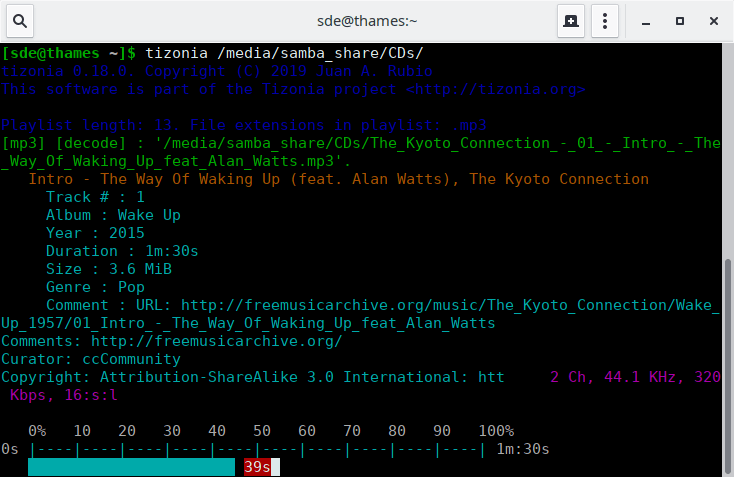Last Updated on April 28, 2023
In Operation
Before looking at the available streaming music services, let’s start with playback of local/network content. Tizonia is a regular music player. The software supports a wide range of formats: mp3, mp2, m2a, aac, (.aac only) flac (.flac, .ogg, .oga), opus (.opus, .ogg, .oga), vorbis (.ogg, .oga), wav, aiff, aif. That’s a good range of formats.
Want a few examples to explain how to play local content? Type:
$ tizonia --help examples
You can play tracks in a directory e.g.
$ tizonia /media/samba_share/CDs/
Here’s an image of playback in action with the software’s handy track progress bar.

An open source music application playing open source music on an open source operating system. As nature intended.
Play the tracks in shuffle mode with the -s flag:
$ tizonia -s /media/samba_share/CDs/
There’s also the option to recursively process a given path. Replace the -s flag with -r.
You can’t feed local playlists to Tizonia in either pls or m3u formats. There is no support for that currently.
You’ll also want to learn the keyboard shortcuts. There are only a few important ones to remember:
[sde@thames ~]$ tizonia --help keyboard tizonia 0.18.0. Copyright (C) 2019 Juan A. Rubio This software is part of the Tizonia project <https://tizonia.org> GNU Lesser GPL version 3 <https://gnu.org/licenses/lgpl.html> This is free software: you are free to change and redistribute it. There is NO WARRANTY, to the extent permitted by law. Keyboard control: [p] skip to previous file. [n] skip to next file. [SPACE] pause playback. [+/-] increase/decrease volume. [m] mute. [q] quit.
You’ll notice there are no keyboard shortcuts for fast forward or rewind. Sadly that functionality is not available. If you like skipping around a track e.g. listening to a specific part of a track a number of times, or listen to podcasts, this omission might be a bit annoying.
Each streaming service offers different functionality. But Tizonia offers useful help functionality explaining the various options.
Tizonia focuses on automatically generated playlists provided by the various services, or user playlists that are located in the cloud. For example, you can create your own playlist in Spotify, Google Play Music, SoundCloud or YouTube and play them back with Tizonia.
Next page: Page 3 – Spotify (Premium)
Pages in this article:
Page 1 – Introduction / Installation
Page 2 – In Operation
Page 3 – Spotify (Premium)
Page 4 – Google Play Music (free and paid)
Page 5 – YouTube
Page 6 – Soundcloud
Page 7 – Other Services and Features
Page 8 – Summary
